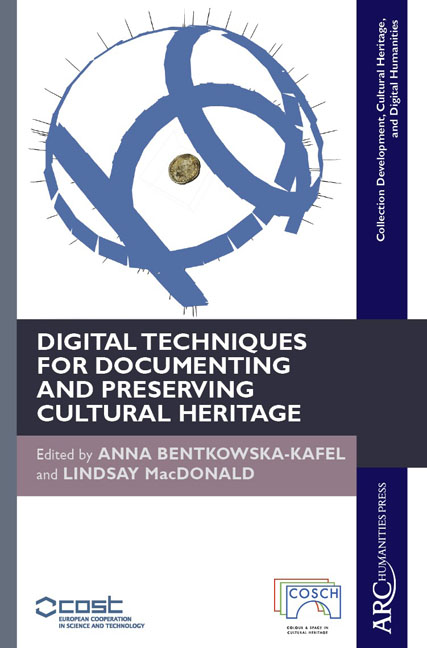Photogrammetry
Published online by Cambridge University Press: 26 January 2021
Summary
COSCH Case Studies that have employed this technology: Kantharos, Roman coins (fig. 19.1), Bremen Cog (fig. 19.2), Germolles (fig. 19.3), White Bastion, Romanian cultural heritage
Definition
Photogrammetry is a metric imaging method that enables digital reconstruction of the form and geometry of a real object in three dimensions. This reconstruction is based on a set of photographic images covering all areas of the surface with enough overlap to enable identification of common details on each photo. Photogrammetry was originally developed around 1860, and can be regarded as the first non-contact measurement method.
Description
Through photogrammetry, a realistic 3D model based on simple photos including detailed and accurate colour recording of the object's surface can be achieved. It is a very good tool for recording cultural heritage objects, of any size and any type. With commercially available cameras, together with recent software developments, photogrammetry has opened up to many end-users.
The data sets are useful at different levels: on-the-ground and on-site recording (e.g., during an archaeological excavation), technical analysis (surfaces and volumetric measurement after post-processing), and public dissemination through dynamic and easy-to-manipulate 3D models.
Digital close-range photogrammetry is a robust and established, non-contact method for the documentation of museum artefacts. The equipment, typically consisting of a digital SLR camera and lighting equipment, scale bars, and a colour target, is easily transportable to museums or other sites. It is capable of recording the current condition and damages on the surface of an artefact offering visualization of details of the order of 50 microns.
Two or more overlapping images are taken from different locations. Measurements of a distribution of common imaged features, usually discrete points, are recorded from which both the image and surface geometry can be solved. If many overlapping images, often termed an “image network,” are taken, it is possible to estimate both the pose and interior optical parameters of the camera and to produce accurate 3D surface measurements with consumer-grade digital cameras. This procedure, termed “self-calibrating bundle adjustment,” is fundamental to many automated 3D image reconstruction procedures when it is combined with automated image feature and area matching processes. Given that colour images are taken, it is a relatively straightforward process to map the colour in the images onto the 3D surface.
- Type
- Chapter
- Information
- Publisher: Amsterdam University PressPrint publication year: 2018



